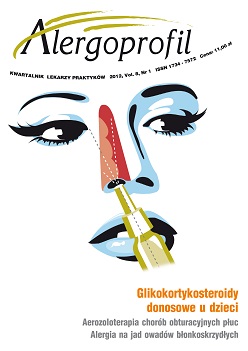Alergia na jad owadów błonkoskrzydłych
##plugins.themes.bootstrap3.article.main##
Abstrakt
Praca przedstawia problem uczulenia na jad owadów błonkoskrzydłych oraz towarzyszące mu zagrożenia. Omówiono obraz kliniczny nadwrażliwości na jad owadów oraz postępowanie diagnostyczne i terapeutyczne. Podkreślono dużą skuteczność swoistej immunoterapii stosowanej w leczeniu zagrożonych wystąpieniem wstrząsu anafilaktycznego chorych. Przedstawiono zasady postępowania w reakcji anafilaktycznej.
Pobrania
##plugins.themes.bootstrap3.article.details##
Copyright: © Medical Education sp. z o.o. This is an Open Access article distributed under the terms of the Attribution-NonCommercial 4.0 International (CC BY-NC 4.0). License (https://creativecommons.org/licenses/by-nc/4.0/), allowing third parties to copy and redistribute the material in any medium or format and to remix, transform, and build upon the material, provided the original work is properly cited and states its license.
Address reprint requests to: Medical Education, Marcin Kuźma (marcin.kuzma@mededu.pl)
Bibliografia
2. Müller U.R.: Insect sting allergy: clinical picture, diagnosis and treatment. Gustav Fischer Verlag, Stuttgart 1990.
3. Novembre E., Cianferoni A., Bernardini R. et al.: Epidemiology of insect venom sensitivity in children and its correlation to clinical and atopic features. Clin. Exp. Allergy 1998, 28: 834-838.
4. Bilo B.M., Rueff F., Mosbech H., Bonifazi F., Oude Elberink J.N.G., the EAACI Interest Group on Insect Venom Hypersensitivity. Diagnosis of Hymenoptera venom allergy. Allergy 2005, 60: 1339-49.
5. Simons F.E.R. et al.: World Allergy Organization Guidelines for the Assessment and Management of Anaphylaxis. J. Allergy Clin. Immunol. 2011, 127: 587-593.
6. Reisman R.E.: Natural history of insect sting allergy. Relationship of severity of symptoms of initial sting anaphylaxis to re-sting reaction. J. Allergy Clin. Immunol. 1992, 90: 335-339.
7. Day J.H.: A comparison of venom concentrations of 0,1 mcg/ml and 1,0 mcg/ml as indicator of sensitivity to honeybee stings. J. Allergy Clin. Immunol. 1986, 77: 142.
8. Georgitis J.W., Reisman R.E.: Venom skin tests in insect-allergic and insect-nonallergic populations. J. Allergy Clin. Immunol. 1985, 76: 803-807.
9. Green-Graif Y., Ewan P.W.: Diagnostic value of the skin prick test and RAST in insect sting allergy. Clin. Allergy 1987, 17: 431-8.
10. Birnbaum J., Vervloet D., Andre S. et al.: Protocole de desensibilisation acceleree aux venins d´hymenopteres. Med. Hyg. 1988, 46: 2405-10.
11. Muller U., Helbling A., Bertchold E.: Immunotherapy with honeybee and yellow jacket venom is different regarding efficacy and safety. J. Allergy Clin. Immunol. 1992, 89: 529-35.
12. Blaauw P.J., Smithuis L.O.M.J.: The evaluation of the common diagnostic methods of hypersensitivity for bee and yellow jacket venom be means of an in-hospital insect sting. J. Allergy Clin. Immunol. 1985, 75: 556-62.
13. Ruef F., Przybilla B., Mueller U. et al.: The sting challenge test in hymenoptera venom allergy. Position paper of the subcommittee on insect allergy of the European Academy of Allergology and Clinical Immunology. Allergy 1996, 51: 216-225.
14. Simons F.E.R.: First-aid treatment of anaphylaxis to food: focus on epinephrine. J. Allergy Clin. Immunol. 2004, 113: 837-44.
15. Pumphrey R.S.H.: Lessons for management of anaphylaxis from a study of fatal reactions. Clin. Exp. Allergy 2000, 30: 1144-1150.

